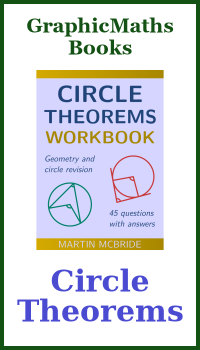Trinary numbers
Categories: number theory

We are all familiar with base 10 numbers (denary). And if you have ever done any computer programming you will also be familiar with base 2 numbers (binary).
This article is about trinary numbers (sometimes called ternary numbers). Trinary numbers use base 3.
Why study these numbers? Well, one important reason is to understand the Cantor set. The Cantor set is based on an iterative process of dividing intervals into three parts. Trinary numbers, in particular trinary fractions, are very useful for analysing the set.
This is a deep dive into trinary numbers that should help if you want to fully appreciate the Cantor set.
Trinary numbers
The trinary system uses base 3. This means that the least significant digit represents 1, next represents 3's, then 9's, 27's, 81's and so on. These values go up in powers of 3 - in other words, the value of each column triples as we move to the left. The value 142 in base 10 is represented like this in base 3:

The base 3 value is calculated like this:

Base 10 uses the digits 0 to 9, but base 3 uses the digits 0, 1 and 2.
Here are the numbers 0 to 10 (denary) in base 3:
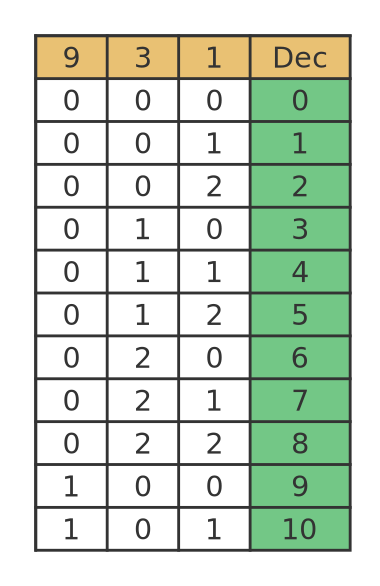
So for example, 5 is made up of 1 times 3 plus 2 times 1. 10 is made up of 1 times 9 plus 1 times 1.
Trinary fractions
In base ten, we use a decimal point to represent fractions. For example the decimal fraction 0.125 represents this value:

The number is equal to 1 tenth, plus 2 hundredths, plus 5 thousandths. That is equal to 125/1000, which of course is 1/8.
In trinary, we can also use a decimal point (or rather, a trinary point). The first digit after the point represents thirds of a unit, the second represents ninths, and the third represents twenty-sevenths. So this trinary number represents 7/9:

The number is equal to 2 thirds, plus 1 ninth, which simplifies to 7/9.
Recurring trinary fractions
In the decimal system, many rational numbers have to be expressed as recurring fractions. The simplest example is a third which is expressed as 0.333 recurring.
In the trinary system, a third is simply expressed as 0.1. There is no recurring number here.
However, there are recurring fractions in trinary too. For example, a half in trinary is 0.111 recurring. This can be shown quite easily, by expanding out the terms in 0.111...:

This can be written in terms of powers of 1/3, like this:

This is an infinite geometric series, and its sum can be written as:

This formula is valid if r is less than 1. In our case, a is 1/3 and r is also 1/3, so the formula is valid. The value (1 - r) is equal to 2/3, so the sum of the series is:

This proves that 0.111 recurring, in base 3, is equal to a half.
As another example, a quarter has the base 3 value of 0.020202 recurring. This can be proved similarly (in this case a is 2/9, r is 1/9, and (1 - r) is 8/9).
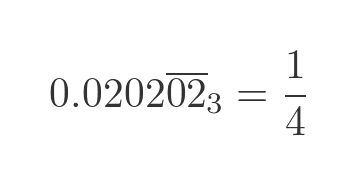
Trinary and recurring twos
With decimal fractions, if we multiply 0.333 recurring by 3, we don't get 1, we get 0.999 recurring. This may seem contradictory, but the reason is that 0.999 recurring is equal to 1.
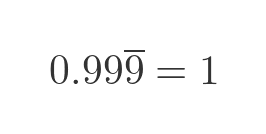
Notice that 0.999 recurring isn't approximately equal to 1, it is exactly equal to 1. It is just a different way to write the number 1. We can prove this using the geometric series formula from earlier. In this case a is 9/10, r is 1/10, so (1 - r) is 9/10:

This doesn't only happen with 1. For example, the same thing happens with 0.035:

In fact, for any decimal number that terminates, we can write the same number by subtracting 1 from the final digit and adding recurring 9s.
Something very similar happens with trinary fractions, but the important digit here is 2 rather than 9. So, for example, these values are identical:
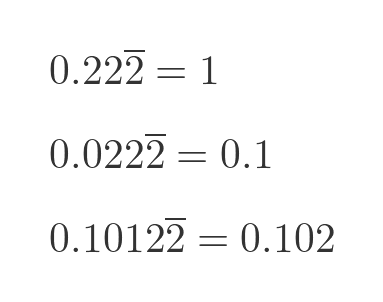
Related articles
Join the GraphicMaths Newsletter
Sign up using this form to receive an email when new content is added to the graphpicmaths or pythoninformer websites:

Popular tags
adder adjacency matrix alu and gate angle answers area argand diagram binary maths cardioid cartesian equation chain rule chord circle cofactor combinations complex modulus complex numbers complex polygon complex power complex root cosh cosine cosine rule countable cpu cube decagon demorgans law derivative determinant diagonal directrix dodecagon e eigenvalue eigenvector ellipse equilateral triangle erf function euclid euler eulers formula eulers identity exercises exponent exponential exterior angle first principles flip-flop focus gabriels horn galileo gamma function gaussian distribution gradient graph hendecagon heptagon heron hexagon hilbert horizontal hyperbola hyperbolic function hyperbolic functions infinity integration integration by parts integration by substitution interior angle inverse function inverse hyperbolic function inverse matrix irrational irrational number irregular polygon isomorphic graph isosceles trapezium isosceles triangle kite koch curve l system lhopitals rule limit line integral locus logarithm maclaurin series major axis matrix matrix algebra mean minor axis n choose r nand gate net newton raphson method nonagon nor gate normal normal distribution not gate octagon or gate parabola parallelogram parametric equation pentagon perimeter permutation matrix permutations pi pi function polar coordinates polynomial power probability probability distribution product rule proof pythagoras proof quadrilateral questions quotient rule radians radius rectangle regular polygon rhombus root sech segment set set-reset flip-flop simpsons rule sine sine rule sinh slope sloping lines solving equations solving triangles square square root squeeze theorem standard curves standard deviation star polygon statistics straight line graphs surface of revolution symmetry tangent tanh transformation transformations translation trapezium triangle turtle graphics uncountable variance vertical volume volume of revolution xnor gate xor gate
